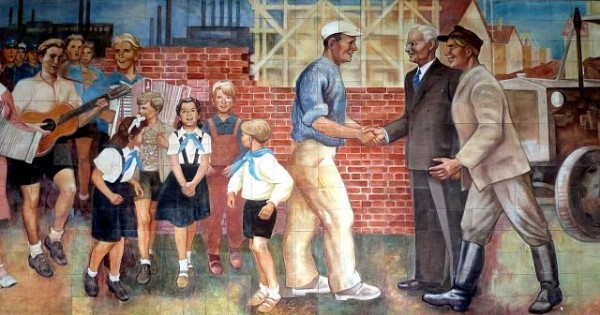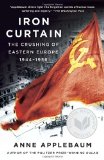Totalitarianism in Practice
Terror as a way of life in East Germany, Poland, and Hungary

Iron Curtain: The Crushing of Eastern Europe, 1945-1956, By Anne Applebaum, Doubleday, 608 pp., $35
“Every artificially inseminated pig is a blow into the face of Imperialist War-mongers!” Such slogans of excruciating dullness and vulgarity governed life in Stalinist Eastern Europe. One Polish competition in 1950 suggested that painters illustrate subjects like “the technology and organization of cattle slaughter” or “the rationalization and mechanization of industrialized pig farms.” School lessons and mass rallies followed suit. As Anne Applebaum observes, “enthusiasm was mandatory.” The idea was to produce a new type of human being who could not even imagine an alternative to Communism. Stalin took very seriously the dictum that the right environment could completely change human nature, which is one reason he remained hostile to both Freudianism and genetics. But to remake humanity, it was necessary to control all aspects of life. There could be no independent organizations—one official sent to postwar Germany was appalled at the number of chess clubs—and the people had to be continually assaulted with propaganda. Above all, the education of youth had to be scientifically monitored. In East Germany, the organization of summer camps occasioned debate in the party’s Central Committee, which dictated details such as the precise number of hours devoted to swimming and singing.
Difficult as it is for us to comprehend, the governments installed by Moscow read their Marx and Lenin not as just another philosophy but as hard science. The appalling economic consequences never shook their faith. In 1946 Hungary suffered what was probably history’s worst bout of inflation, with the value of the pengö declining by the hour and people pressured to spend as soon as they were paid. By the time a new currency unit, the forint, was introduced, it was worth 400,000 quadrillion pengö.
We read of a Polish economic planner trying to set the “correct” prices for all goods, with the assumption that they would never change. He at last realized there was no need to do any more research, since presumably the Soviets had already determined all correct prices. In 1950, Spain and Poland had an almost identical GDP, but by 1988 Spain’s was more than five times Poland’s. The only available explanation for failure was sabotage, and bad economic news occasioned a wave of arrests.
Terror became a way of life. After the Allies liberated Nazi concentration camps, the Soviets reopened them. Sachsenhausen was renamed Special Camp Number 7; Buchenwald became Special Camp Number 2. East German camps held children for crimes like having made faces during a lecture on Stalin. Local Communist parties also set up their own concentration camps, modeled, of course, on the Soviet gulag.
As in Russia, people were arrested not just for what they did but also for what they might do, as “potential enemies.” The Polish secret police developed a list of 25 categories of suspicious people, and more catego- ries were always being added. These included priests, former members of non-Communist socialist parties, and anyone who had seen the West. Eventually, the number of potential enemies encompassed one in three adults. When a counterrevolutionary was arrested, it was common to follow the Soviet practice of arresting his family as well, then his friends, and then the acquaintances of his friends.
Focusing on East Germany, Hungary, and Poland, Applebaum devotes one half of her study to the establishment of Stalinist regimes and the other to High Stalinism. The Yalta agreement guaranteed Poland “free and unfettered elections,” and at first the Communists felt confident that with the help of a little fraud and intimidation, they could win. As one Hungarian official recommending fraud explained, “Comrades, you should not be too law-abiding.” Even so, Communists did worse than they expected.
 Early on they settled for coalition governments. As East German leader Walter Ulbricht explained, “It’s quite clear—it’s got to look democratic. But we must have everything under our control.” Other parties might run theagriculture ministry, but the Communists controlled the secret police, which was enough for them to seize full power throughout Eastern Europe by 1948. The story of how they outmaneuvered the Church, Western diplomats, opposition parties, and even the workers in whose name they ruled makes compelling reading.
Early on they settled for coalition governments. As East German leader Walter Ulbricht explained, “It’s quite clear—it’s got to look democratic. But we must have everything under our control.” Other parties might run theagriculture ministry, but the Communists controlled the secret police, which was enough for them to seize full power throughout Eastern Europe by 1948. The story of how they outmaneuvered the Church, Western diplomats, opposition parties, and even the workers in whose name they ruled makes compelling reading.
Applebaum is at her best in describing the feel of life after 1948. What compromises did people make and how did they relate to each other? What was it like in a world where spouses were paid to spy on each other and children reported on their parents? Some people engaged in “self-brainwashing,” others constructed multiple lives with a different self for each milieu.
As in Russia, they told pointed jokes. One concerned a sculptural monument to the poet Push- kin, which turned out to be a giant statue of Stalin reading a tiny book labeled Pushkin’s Poems. Jokes, of course, could earn one a trip to the gulag, but even government officials told them. One journalist explained that he and his comrades con- vinced themselves that such humor was temporary because when all social problems were at last solved, “there wouldn’t be any more jokes because there wouldn’t be anything left to joke about.”
Hannah Arendt called the East European experience just an uninteresting repetition of the Russian one, but Applebaum contends that knowing how totalitarianism was imposed in several different countries sheds new light on the concept. To be sure, the steps taken to impose rule and the adjustments forced by different societies tell us something, but Applebaum’s contribution lies in her understanding of what she calls “real totalitarianism—not totalitarianism in theory but totalitarianism in practice.” We sense what it was like for ordinary people. Through her archival work and interviews, she gives us the experiences that shaped the stories they remembered.
Before a nation can be rebuilt, Applebaum observes, people “need to know particular details … and they need to hear individual stories, not generalizations about the masses. They need a better grasp of what motivated their predecessors, to see them as real people and not as black-and-white caricatures, victims, or villains.” Her book succeeds, better than any I know, in conveying the sense of how lives very different from our own were lived.

